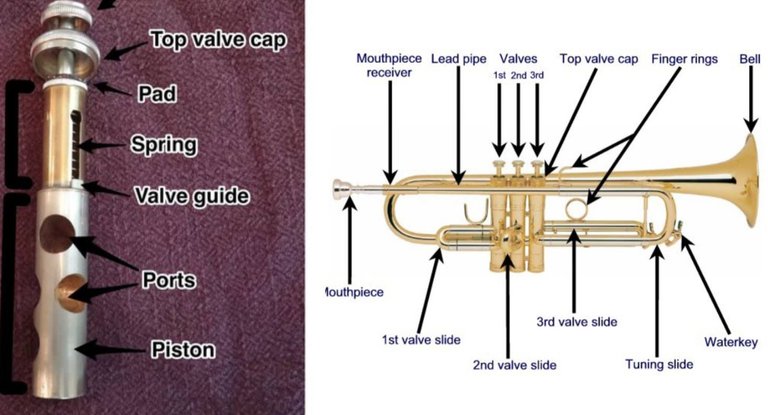
By definition, brass instruments don't even have to be made out of brass. Brass instruments are any musical instruments that are played by blowing air out of your mouth while vibrating your lips. This includes the conch shell, which is made out of shell, and the alphorn and the didgeridoo, which are made out of wood, as well as plastic 'brass instruments' like the plastic trumpet and plastic tuba.
The more tubing there is in a brass instrument, the lower pitched that instrument is. For example, a typical Bb trumpet has about 1.5 meters (5 ft) of tubing. If you play an open-valve low trumpet C, it will produce an octave 3 concert-pitch Bb (piano Bb). Trombones, however, typically have around 3 meters (9.5 ft) of tubing, and will produce notes one octave lower than the trumpet (default Bb will be octave 2). The length of tubing has to increase exponentially for lower octaves, like piano strings, so a tuba generally has around 5.5 meters (18 ft) of tubing, and will be one octave lower than the trombone (octave 1).
The fact that more tubing makes lower pitches is how valves work. Valves have pistons on the bottom, with ports (holes) in them (see picture below). So when you press a valve down, the ports move down to the point where they connect to more tubing (valve slides). So, for example, when you press the second valve down on a trumpet, the ports on the second valve piston will connect to ports to the second valve slide.
Basically, with no valves down, the air you blow into the trumpet is going straight from the mouthpiece, through the main tube, straight through the valves, and out the bell. But when you press the second valve down, the air is forced into the second valve slide when it goes through the valves, then through the rest of the main tube and out the bell. This longer travel of air causes the resulting pitch to be lower. All of this applies to all brass instruments with valves.

In general, the 1st valve lowers the pitch by 2 semitones, the 2nd valve lowers the pitch by 1 semitone, and the 3rd valve lowers the pitch by 3 semitones, these can be used in combination for a full 12 semitone scale.
So, you might be asking, "why does the pitch naturally go up from C to D (concert-pitch Bb to C) when i go from open-valve to pressing valves 1 and 3, if pressing valves lowers the pitch?" . And the reason for that is bugling. Bugling is when you play different notes without changing any valves. For example, playing C, up to G, then upper C (concert-pitch Bb, up to F, then upper Bb). Bugling is simply playing the harmonic scale. So whe you are playing C, and you press valves 1 and 3, you are lowering the pitch by 5 semitones to a low G, and simultaneously bugling up to a D. The concert-pitch equivalent would be playing Bb, pressing valves 1 and 3 and lowering the pitch to a low F, and naturally bugling up to a C. If this is confusing, use the picture below as a reference.

Now, trombones are different altogether, but much simpler. Think of a trombone as a trumpet with one giant valve slide. when you move the slide to 2nd position, the length of tubing you just extended the air pathway by is equivalent to the length of the 2nd valve slide on a trumpet. If the instruments are in the same effective key, and playing the same bugle, 2nd position will have the same pitch (maybe with octave differences) as 2nd valve on a trumpet.
You could also think of a trumpet as a trombone with 3 different length slides, each one always the same length, and when you press the corresponding valves down, the air pathway opens up those slides and makes the air go through them.
Some instruments have 4, 5, or even 6 valves. In these cases, the 4th valve lowers the pitch by 5 semitones, (equivalent to pressing valves 1 and 3). The 5th valve is for getting that otherwise unreachable super low concert C, because when you get that low, the instrument becomes so sharp that it goes up one semitone, so the normal C fingering becomes C# so you have to skip to pedal Bb. And the 6th valve is just crazy.
Rotors and triggers are pretty much valves, but probably better,
If you disagree with anything here, please tell me, I'm not a professional! Also, if you have any questions, feel free to ask.
Thank you for reading!
Congratulations @loaflink! You have completed some achievement on Steemit and have been rewarded with new badge(s) :
Click on any badge to view your own Board of Honor on SteemitBoard.
For more information about SteemitBoard, click here
If you no longer want to receive notifications, reply to this comment with the word
STOP